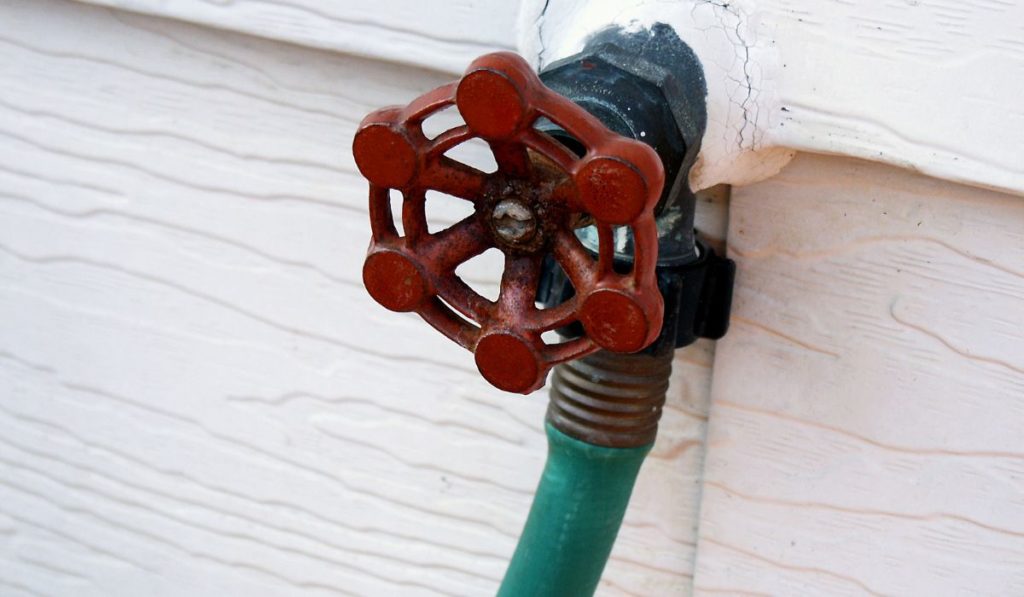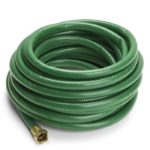A hose getting stuck on the faucet or spigot is a common problem that you’re likely to face at some point. Given the changing seasons, the freezing and thawing of water, and debris that builds up over time, things tend to get stuck. So, how can you solve this frustrating issue?
To get a hose unstuck, you can twist it off using pliers and WD-40, CLR, or PAM cooking spray. If that doesn’t work, you can use a hacksaw to cut it off at a 45 degree angle. Preventing your hose from getting stuck again is as simple as loosening it every month and removing it during the winter.
Removing a stuck hose can be a simple task that’ll just take a few minutes, but if it’s on there pretty well then some more extreme measures might be necessary. Let’s take a closer look at how to get your hose off the spigot — and how to prevent it from getting stuck in the future.
How Do You Get a Stuck Garden Hose Off of a Spigot

Getting a hose unstuck will require one or several of the following tools. See what you’ve already got on hand, and hopefully it’ll be sufficient to get the job done.
- Gardening or utility gloves (on Amazon)
- Hacksaw (on Amazon)
- Flathead screwdriver (on Amazon)
- Tongue-and-groove pliers (on Amazon)
- Utility knife or scissors (on Amazon)
- WD-40 (on Amazon)
- CLR (on Amazon)
- PAM cooking spray (on Amazon)
Twisting the Hose
Sometimes we can accidentally tighten the hose instead of loosening it. So before we attempt other more invasive steps, try to turn the hose counterclockwise with a pair of gloves on and see if it will loosen enough to take it off. Gently move the hose back and forth and side to side as this can also loosen debris that might be cementing it into place.
If using your hands doesn’t work, try to turn it with a wrench or a pair of pliers since this can provide better grip. You can also try adding some WD-40 to the inside threads to help loosen things up.
Applying CLR (calcium, lime, and rust remover) can also help erode some of that rust that might be stopping the hose from disconnecting. Pour some CLR onto the connection between the hose and the spigot and scrub it with a toothbrush. Wait an hour and then try to twist the hose free once more.
The third option is to use PAM cooking spray and spray it around the connector to try and loosen the hold on the hose.
Cut the Hose Connector
Sometimes the hose won’t come off with all the above tricks. So the next step is something more invasive and permanent, which is cutting it off using a hacksaw.
The first step is to use the hacksaw to cut into the hose connector. In some cases, you might need a mini hacksaw (on Amazon) in order to maneuver in a tight space. The hose connector is the fitting that attaches to the spigot. Make sure you cut the connector at a 45-degree angle and aren’t slicing into the threaded pipe underneath.
Placing the flathead screwdriver into the cut you just made, you want to pry it open. Be sure to wear your utility gloves as sharp edges can result from this task.
Unscrew the hose connector with the pliers in a clockwise fashion. Doing this should make the connector loose enough that the garden hose can now be removed with a little effort.
How Do You Keep a Hose From Getting Stuck on a Spigot?

Preventing your hose from getting stuck on the spigot is probably a better idea than needing to cut it off each turn of the season. Here are some tips for avoiding a stuck hose:
- Avoid aluminum fittings and sticking strictly to brass ones can help prevent it from getting stuck almost entirely. That said, brass fittings do have the issue of corrosion.
- Loosening the hose every month can stop corrosion as well as a build up of debris and rust from accumulating and causing the hose to get stuck. When you do this, be sure to clean any visible corrosion you see on the actual hose.
- Coat the threads of your aluminum or brass fittings with silicone grease (on Amazon).
- Store your hose indoors during the winter months.








